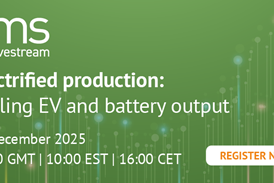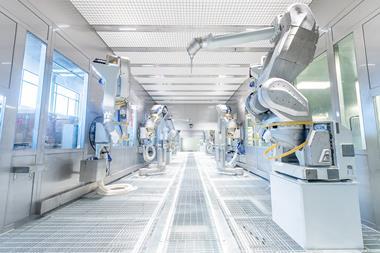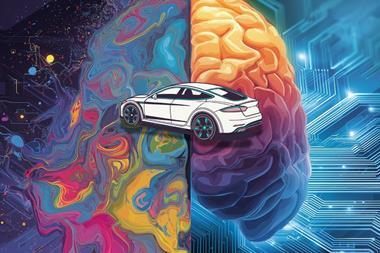System experts at Dürr have developed a digital maintenance assistant designed to keep automotive paintshops in full effect
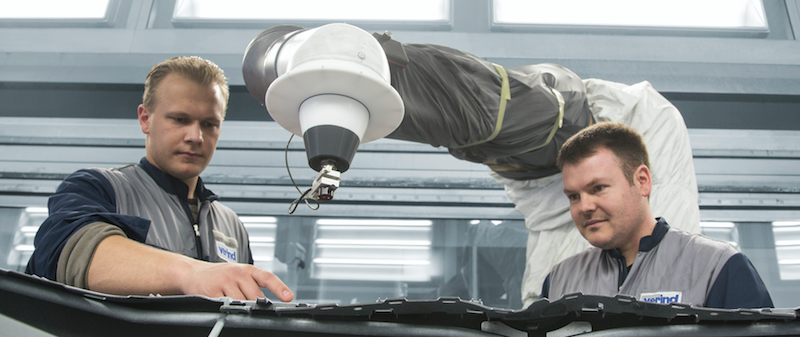 With its digital@Dürr concept, Dürr is delivering an important smart factory module. In future, the company will be supporting customers in maintaining painting and sealing robots using a digital maintenance assistant. With the help of a traffic-light system, the software shows the current maintenance needs and simultaneously indicates work that will shortly be pending. In doing so, the intelligent system orients itself on the actual condition of the plant. This ensures high availability over the long term. An illuminated green wrench on the screen indicates that everything is fine. If the light is yellow, maintenance should be planned in the near future. If it is red, maintenance work is required immediately.
With its digital@Dürr concept, Dürr is delivering an important smart factory module. In future, the company will be supporting customers in maintaining painting and sealing robots using a digital maintenance assistant. With the help of a traffic-light system, the software shows the current maintenance needs and simultaneously indicates work that will shortly be pending. In doing so, the intelligent system orients itself on the actual condition of the plant. This ensures high availability over the long term. An illuminated green wrench on the screen indicates that everything is fine. If the light is yellow, maintenance should be planned in the near future. If it is red, maintenance work is required immediately.
With this intuitive system, the new EcoScreen Maintenance Assistant from Dürr provides targeted information about upcoming measures to the maintenance personnel. In the newly developed software, Dürr has integrated an entire series of functions that support trouble-free operation of the robots. In the past, the type and time of maintenance tasks were documented in an instruction manual.
Multiple advantages“Maintenance is now oriented to the actual use of the individual plant components and is not performed according to purely time-based maintenance intervals,” says Dr. Hans Schumacher, President and CEO of the Dürr Division Application Technology, explaining the new method of the digital maintenance assistant. This produces multiple advantages. First, the existing maintenance plans are clearly arranged in digital form, and the maintenance history is also documented online and made available at the push of a button.
“The actual condition of a painting booth is determined using everything from component operating times, counters and test functions to intelligent wear models. This preventive maintenance planning is essential for further service measures, which in turn increase the plant uptime availability over the long term,” says Dr. Schumacher.
Intuitive user guidanceThe new EcoScreen Maintenance Assistant software determines the plant condition – for example, from the number of valve switching cycles or from the servo motor load profiles. The due date of pending maintenance tasks is clearly shown on the monitor by means of the traffic-light function. Further detailed information is stored for the individual maintenance tasks.The location of the component requiring maintenance in the plant and the service steps to be performed sequentially are shown in graphic form. Furthermore, additional assistance like films or experiences from the maintenance history can be supplemented in the system. The new software has been in use with the first customers since the beginning of 2016.
Maintenance planning using actual conditionThe intelligent test functions, from which the plant equipment’s condition can be determined, go one step further. “For example, the operating personnel can carry out valve, brake or pump tests. Parameters are determined from the resulting recorded data to inform the operator about currently required or soon to be expected maintenance measures,” explains Dr. Schumacher. These tests can be individually started by the operating personnel or automatically – for example, after a pause in production.
The application area is varied. For example, during the valve test, the valve switching function in the atomiser can be determined through analysis of the pressure characteristics. The traffic-light function then shows on the monitor whether a valve is to be replaced immediately or whether everything is functioning reliably.
Intelligent wear modelsIndependent system data analyses are another innovation. Using intelligent model calculations, it will be possible to perform long-term observations and make comparisons across robots and stations. For example, a specific signal characteristic of the speed controller for the turbine in the high-rotation atomiser can indicate the relationship between pressure and rotation speed on the atomiser. Hence, the system can conclude whether the compressed air supply is working correctly.
Using these data analyses, the pure runtime monitoring of a plant is replaced with individual wear models of the plant components and is thereby transformed into real status detection. The corresponding maintenance intervals can be continuously optimised this way. The system can be used online, which means the system operator can access the painting and sealing robots at any time using the mobile tablet PC EcoPad. Remote access by Dürr service personnel can also be ensured if necessary. The intelligent system has recently been used for the first time in practice worldwide.
ProfileThe Dürr Group is one of the world’s leading mechanical and plant engineering firms with extensive expertise in automation, digitisation and Industry 4.0. Products, systems and services offered by the group enable highly efficient manufacturing processes in different industries. Dürr supplies sectors like the automotive, mechanical engineering, chemical, pharmaceutical and woodworking. Across 92 business locations in 31 countries, the group generated sales of €3.71 billion in 2017. Dürr has around 15,000 employees and operates in the markets such as five divisions: paint and final assembly systems, application technology; clean technology systems; and measuring and process systems.
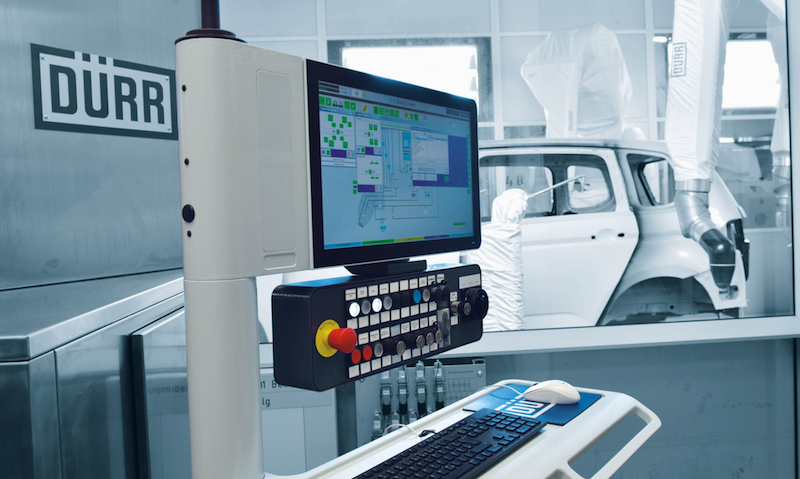 Further growth through EV production technologyAt Dürr, business in production technology for alternatively-powered vehicles cars is gathering pace. Aside from established carmakers, new producers of battery-powered vehicles are also investing in the construction of paint shops and assembly lines. Recently, the Chinese Future Mobility Corporation (FMC) has placed one of the largest e-mobility orders to date. Dürr is building a paint shop for FMC’s Byton brand in Nanjing for 150,000 cars per year.
Further growth through EV production technologyAt Dürr, business in production technology for alternatively-powered vehicles cars is gathering pace. Aside from established carmakers, new producers of battery-powered vehicles are also investing in the construction of paint shops and assembly lines. Recently, the Chinese Future Mobility Corporation (FMC) has placed one of the largest e-mobility orders to date. Dürr is building a paint shop for FMC’s Byton brand in Nanjing for 150,000 cars per year.
Byton stands for electric, networked and highly automated driving. FMC also uses the latest standards in its manufacturing operations. The paint shop, which was ordered in the first quarter of 2018, will be equipped, e.g., with the new EcoInCure technology for curing freshly applied paint. EcoInCure reduces the space required in Nanjing by 20 % and heats all car body parts evenly. For modern vehicles, in which materials such as steel, aluminium and composites are combined, this is an important factor and crucial to ensuring quality. Paint application at FMC in Nanjing will be performed automatically using robots. Production start for the paint shop is scheduled for October 2019.
In 2017, Dürr already achieved sales of around €250m from production technology for electric cars. Going forward, the company expects this figure to increase substantially. Ralf W. Dieter, CEO of Dürr AG: “Electromobility is still in its infancy. As production grows, so will the demand for the necessary manufacturing systems. We are prepared for this – not just in painting technology, but also by offering highly automated solutions for the final assembly, filling and testing of e-cars.” In final assembly, in particular, production processes will change as a result of e-mobility, since the power train of battery-operated e-cars is less complex than that of vehicles with combustion engines. This enables a higher level of automation in assembly.









